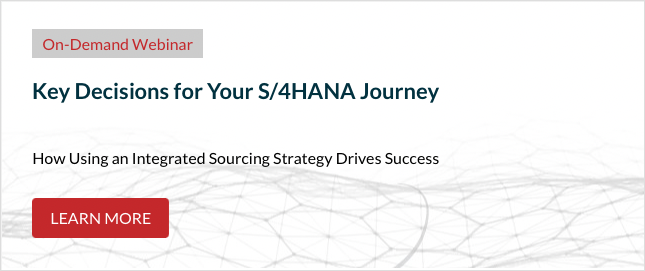- March 25, 2020
- Len Riley
- Reading Time: 6 minutes

Conducting a Phase 0 Effort Before Contacting SAP is the Key to Negotiating the Best S/4HANA Contract
Although SAP ECC end of support was extended to 2027 (with some caveats), companies should not delay the planning of their SAP license conversion strategy. S/4HANA migrations are complex endeavors but they also present IT cost optimization opportunities along with the opportunity to negotiate better commercial terms with SAP. However, making the most of the situation requires a well-thought-out approach for migrating to S/4HANA, a deep understanding of your current SAP footprint, and an understanding of how the market is evolving.
Before even contacting SAP to initiate an S/4HANA migration, follow these steps to establish a solid S/4HANA negotiation strategy.
1. Understand SAP’s S/4HANA Go-to Market Strategy
Taking the time to understand SAP’s goals and event-based sales strategy will help customers better prepare for SAP’s aggressive sales tactics. We have seen SAP use multiple business practices to opportunistically create events that push customers to move to S/4HANA as quickly as possible. They drive sales of S/4HANA by capitalizing on M&As, leveraging Indirect/Digital Access audits, incentivizing customers to migrate now, and penalizing those who wait.
The short video below highlights some of the strategies that SAP uses to influence digital transformations and eliminate the customer’s ability to shape their journey to S/4HANA. This QuickCast is a 4-minuite snapshot of our full webcast recording which further details how you can take control of your SAP technology roadmap.
2. Assess Your Current ECC Application Landscape and ECC User Footprint
Prior to engaging with SAP on your S/4HANA roadmap, start by getting a ‘lay of the land’ of your ECC application landscape and user footprint. Your internal assessment should evaluate:
-
- How many ECC user licenses your company has purchased and the type
- How many ECC user licenses by type you are leveraging today
- Which metric-based applications your company purchased and how many units were purchased
- Which metric-based applications you are leveraging today
- Which metric-based applications you anticipate using in the future and at what entitlement level
Counting how many ECC user licenses you purchased and are currently using may be straightforward, but companies often overlook the chance to internally rationalize users prior to SAP’s positioning of an audit. For example, many companies run LAW reports and realize that they have assigned ‘Professional Users’ when they could have assigned ‘Limited Professionals’ which are significantly less expensive.
Take this opportunity to rationalize your user footprint to ensure the appropriate license levels are assigned and resources are not leveraging higher-level ECC users than are necessary. This is a critical step that allows you to come to the negotiation table with a current- and future-state understanding of your SAP ECC application landscape, which ultimately translates to cost-cutting levers that can be pulled during the course of your S/4HANA negotiations.
3. Identify Opportunities to Retire Technical Debt
Once you understand your current SAP ECC application landscape, you can use your total net license fees and utilization percentage to calculate your maintenance cost and determine whether you are overpaying for SAP maintenance. We typically see SAP customers utilizing around 70-75% of their licenses. While that may sound like a decent utilization percentage, calculating the cost of that underutilization component can reveal some staggering numbers for large enterprises, especially when looking at it on an annual basis.
Remember that there are opposing motivations in SAP ECC to S/4HANA migrations. While you look for cost optimization opportunities related to your underutilization, SAP will zero in on potential overutilization so they can position compliance issues and attempt to increase your costs with a true-up.
That being said, SAP has been willing to provide the ability to terminate shelfware during strategic negotiations which ultimately reduces ongoing maintenance. Therefore, leverage this inflection point to terminate the applications you do not use now or plan to use in the future. This will provide some relief to your ongoing maintenance as you plan to add additional S/4HANA applications to your SAP application landscape.
We have also seen SAP willing to provide customers with conversion credits to make the migration from ECC to S/4HANA more palatable from a software and maintenance perspective. Therefore, position ECC to S/4 conversion credits with SAP along with visibility into calculations and what ECC applications will ultimately be terminated.
4. Assess Your Indirect Access/Digital Access Risk
Whether you have taken advantage of SAP’s Digital Access Adoption Program or have decided to stay on Indirect Access, it is critical that you consider your potential compliance exposure before engaging with SAP. Engaging SAP is an invitation for them to assess your usage with a fine-tooth comb. For those companies embarking on Phase 0 efforts, it is a great time to understand and educate your team on SAP’s Indirect/Digital Access announcements, in-scope scenarios, out-of-scope scenarios, metrics, and pricing.
Leveraging this level of intelligence, you can assess what your risk looks like today and what you anticipate it to look like in the future. This will enable your company to come to the negotiation table with a point of view on perceived risk so you can ensure you are not paying more than you need to for Indirect Access (now and in the future).
Leveraging the results of your self-assessment, you can determine the type of Indirect Access construct that makes the most sense for your company, along with predictable pricing. If your risk is low and will remain that way, you may choose to negotiate away additional Indirect Access risk through highly competitive price protections. On the flip side, if your risk is high and is anticipated to continue in that direction, you may choose to negotiate alternative licensing constructs to avoid Indirect Access altogether.
5. Evaluate Which HANA Database is Right for You
SAP has made HANA the only relational database that S/4HANA will run on. So if you haven’t already purchased HANA, SAP will position one of two options, HANA Runtime or HANA full-use, based on their understanding of your requirements. Unless prompted, SAP typically does not provide visibility into the functionality differences between HANA Runtime and HANA full-use.
However, SAP generally positions HANA Runtime which is much more restrictive and does not fully support advanced analytics which many companies intend to leverage in the long-term to remain competitive. For this reason, many companies that buy HANA Runtime end up buying HANA full-use later on in order to leverage the fully supported advanced analytics it provides.
Beyond functional differences, pricing between the two databases is also not typically provided. HANA Runtime is priced based on a percentage of your HANA SAP Application Value (“HSAV”) (with varying costs for HANA Runtime and HANA Runtime for Applications and BW) and HANA full-use is priced on your actual GB requirements. In other words, HANA Runtime acts as a tax on all previous and future SAP investments while HANA full-use is based on your actual database requirements. Since database requirements are difficult for some customers to calculate, many select HANA Runtime as the interim database solution.
Understanding the capabilities and pricing of each of the HANA databases will help you make an educated decision on which HANA database is best for your company. As previously mentioned, many companies start their S/4HANA journey with HANA Runtime, but purchase HANA full-use shortly thereafter. If this is your situation or you anticipate starting with HANA Runtime, negotiate flexibility to switch to HANA full-use along with a credit, if needed.
6. Determine S/4HANA User Demand
Once you have assessed and rationalized your current ECC user footprint, you can then determine your S/4HANA user demand. For S/4HANA, specifically, you can leverage your pre-existing user licenses and therefore only need to worry about the additional demand you may have. Focus on the near-term or more immediate demand and leverage the strategic nature of your S/4HANA investment to negotiate highly competitive price protections that allow you to license additional users if you require them in the future.
These are just a few of the steps we recommend all SAP customers take at the start of their S/4HANA journey. Taking the time during your Phase 0 effort to assess your situation and develop a strategy for an S/4HANA transformation prior to engaging with SAP can significantly reduce your TCO. The key is to develop a holistic S/4HANA migration strategy that includes all aspects of your eventual S/4HANA environment such as the database, applications, users, and Indirect/Digital Access.
Conducting foundational assessments of each layer will ultimately lead to better, educated decision-making and highly competitive forward-looking commercial constructs. What differentiates a highly effective CIO is their choice to lead the engagement rather than be run by the strategies of SAP and their consulting partners.
Comment below and follow UpperEdge on Twitter and LinkedIn. Learn more about our SAP Commercial Advisory Services.


